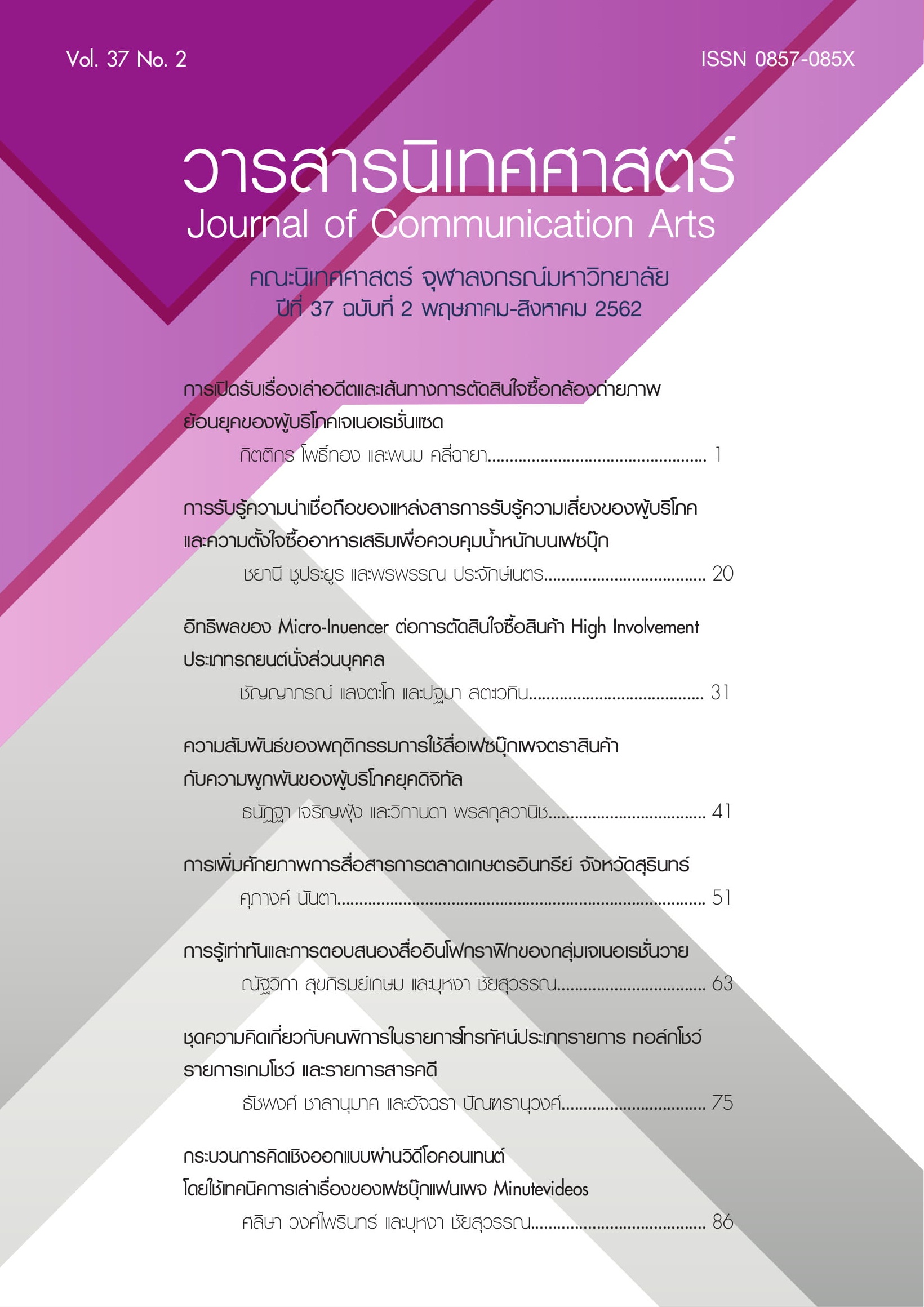การเปิดรับเรื่องเล่าอดีตและเส้นทางการตัดสินใจซื้อกล้องถ่ายภาพย้อนยุคของผู้บริโภคเจเนอเรชั่นแซด
Main Article Content
บทคัดย่อ
การวิจัยนี้มีจุดประสงค์เพื่ออธิบายเส้นทางการตัดสินใจซื้อกล้องถ่ายภาพย้อนยุคของผู้บริโภคเจ- เนอเรชั่นแซดและการเปิดรับเรื่องเล่าอดีต ซึ่งเป็นวิจัยเชิงคุณภาพที่ใช้วิธีวิจัยร่วมกันได้แก่ การสัมภาษณ์เชิงลึก การสนทนากลุ่มและการศึกษาเอกสารที่เกี่ยวข้อง โดยศึกษาในผู้บริโภคเจเนอเรชั่นแซดที่เกิดในปี พ.ศ.2538 –2544 แบ่งเป็นนักเรียนชั้นมัธยมศึกษาตอนปลาย นิสิต นักศึกษา ระดับอุดมศึกษาที่เคยตัดสินใจซื้อและใช้กล้องถ่ายภาพย้อนยุคแบบฟิล์มและแบบดิจิทัลในพื้นที่กรุงเทพมหานคร ผลการวิจัยพบว่า ผู้บริโภคเจเนอเรชั่นแซดเปิดรับเรื่องเล่าอดีตจากพ่อแม่หรือคนในครอบครัว ที่มักจะเล่าเรื่องราวเหตุการณ์ในอดีตของตนเองผ่านภาพถ่ายเก่า ภาพยนตร์เก่า หรือพูดถึงกล้องถ่ายภาพและการถ่ายภาพ ผู้บริโภคเจเนอเรชั่นแซดจึงคุ้นเคยกับกล้องถ่ายภาพแบบเก่าและมีความโหยหาอดีต โดยที่เรื่องเล่าอดีตเป็นสิ่งเร้าและนำไปสู่ความต้องการใช้กล้องถ่ายภาพย้อนยุค สำหรับเส้นทางการตัดสินใจซื้อกล้องถ่ายภาพย้อนยุคของผู้บริโภคเจเนอเรชั่นแซด เริ่มต้นจากการพบเห็นภาพถ่ายเก่า กล้องถ่ายภาพแบบเก่า หรือได้ทดลองใช้กล้องถ่ายภาพแบบเก่า เป็นจุดเริ่มต้นความต้องการที่นำไปสู่ขั้นการพิจารณาและค้นหาข้อมูลในขั้นการประเมินทางเลือก โดยค้นหาข้อมูลจากแหล่งข้อมูลภายนอกและภายในร้านค้าจนเพียงพอต่อการตัดสินใจเลือกในขั้นการตัดสินใจและซื้อ หลังจากซื้อสินค้าแล้วผู้บริโภคจะมีประสบการณ์หลังการซื้อผ่านการใช้สินค้าและหาข้อมูลเพิ่มเติมเกี่ยวกับสินค้า รวมถึงแนะนำบอกต่อข้อมูลสินค้าแก่ผู้อื่น ซึ่งการให้ข้อมูลนี้จะกลายเป็นข้อมูลประกอบการตัดสินใจหรือเป็นจุดเริ่มต้นความต้องการของผู้บริโภคคนอื่น ๆ ผลการวิจัยบ่งชี้ว่าการเปิดรับเรื่องเล่าอดีตและเส้นทางการตัดสินใจซื้อกล้องถ่ายภาพย้อนยุคมีความเกี่ยวข้องกัน โดยการเปิดรับเรื่องเล่าอดีตเป็นสิ่งเร้าที่เชื่อมโยงไปสู่ความโหยหาอดีตในผู้บริโภคเจเนอเรชั่นแซด ความโหยหาอดีตและความคุ้นเคยกับภาพถ่ายเก่า กล้องถ่ายภาพเก่าหรือภาพยนตร์เก่า เป็นจุดเริ่มต้นความต้องการในเส้นทางการตัดสินใจซื้อกล้องถ่ายภาพย้อนยุคของ ผู้บริโภคเจเนอเรชั่นแซด
Article Details
เอกสารอ้างอิง
ฉลองศักดิ์ สุขใจธรรม. (2559). เมื่อเสียง “ชัตเตอร์” กล้อง MIRRORLESS ดังกว่า DSLR. Marketeer. วันที่เข้าถึงข้อมูล 10 เมษายน 2560, แหล่งที่มา http://fliphtml5.com/zyyv/ghzq/basic
นันทพร สุวรรนาวุธ, จารุนาฎ เลิศสกุลเจริญ, วัชราภรณ์ อรานุเวชภัณฑ์, ไพฑูรย์ มินขุนทด, และพัลลภา ปิติสันต์. (2553). Retro Marketing: อดีตที่เรียกคืนได้. For Quanlity Trend, 17(151), 22-25.
ผู้จัดการรายวัน. (2551, 1 ธันวาคม). "โลโม โซไซตี้" เพี้ยนและจัดจ้าน. ผู้จัดการออนไลน์. วันที่เข้าถึงข้อมูล 21 เมษายน 2560, แหล่งที่มา http://www.manager.co.th/Daily/ViewNews.aspx?NewsID =9510000141098
พัฒนา กิตติอาษา. (2546). มานุษวิทยากับการศึกษาปรากฏการณ์โหยหาอดีตในสังคมไทยร่วมสมัย. กรุงเทพมหานคร: ศูนย์มานุษยวิทยาสิรินทร.
รุ้งนภา ยรรยงเกษมสุข. (2555). การโหยหาอดีต: ความเป็นอดีตในสังคมสมัยใหม่. วารสารการเมือง การบริหาร และกฎหมาย, 4(2), 59-89.
โลโมกราฟี. (2559). คำแนะนำการใช้คู่มือเลือกสินค้าประจำปี 2016. วันที่เข้าถึงข้อมูล 2 เมษายน 2560, แหล่งที่มา http://www.lomography.co.th/magazine/325546-the-lomography-holiday-gift-guide-2016-th
Atsmon, Y., Kuentz, J.-F., & Seong, J. (2012). Building brands in emerging markets. McKinsey Quarterly, (September). 22-30.
Bosomworth, D. (2015). The consumer decision journey. Retrieved April 7, 2016, from http://www.smartinsights.com/marketplace-analysis/consumer-buying-behaviour/what-influences-purchase/
Court, D., & Elzinga, D. (2010). Branding in the digital age: You’re spending your money in all the wrong places. Harvard Business Review, (December), 1-8.
Court, D., Elzinga, D., Mulder, S., & Vetvik, O. J. (2009a). The consumer decision journey. Retrieved April 11, 2016, from http://www.mckinsey.com/business-functions/ marketing-and-sales/our-insights/the-consumer-decision-journey
Court, D., Elzinga, D., Mulder, S., & Vetvik, O. J. (2009b). The consumer decision journey. McKinsey Quarterly, (3), 96-107.
Dowd, T., Niederman, M., Fry, M., & Steiff, J. (2013). Storytelling across worlds: Transmedia for creatives and producers: Waltham, MA: Focal Press.
Eck, J. (2006). An analysis of the effectiveness of storytelling with adult learners in supervisory management (Master's thesis), Available from http://www2.uwstout.edu/content/lib/thesis/2006/2006eckj.pdf
Kotler, P., & Keller, K. L. (2012). Marketing management (14th ed.). Boston, MA: Pearson.
Lecinski, J. (2011). Winning the Zero Moment of Truth. Menlo Park, CA: Google.
Levickaite, R. (2010). Generations X, Y, Z: How social networks form the concept of the world without borders (the case of Lithuania). Limes, 3(2). doi:10.3846/limes.2010.17
Miller, E. (2011). Theories of story and storytelling. Retrieved April 12, 2016, from http://www.storytellingandvideoconferencing.com/67.pdf
Morgan, S., & Dennehy, R. F. (1997). The power of organizational storytelling: A management development perspective. Journal of Management Development, 16(7), 494-501.
Nielsen. (2015, Nov 17). Millennials and generation Z are more traditional than you may think. PR Newswire. Retrieved April 4, 2016, from https://www.prnewswire.com/news-releases/millennials-and-generation-z-are-more-traditional-than-you-may-think-300180246.html
Rammopo, K. (2016, May 18). Generation Z: The new generation consumer. Bizcommunity. Retrieved April 4, 2016, from https://www.bizcommunity.com/Article/196/347/ 144912.html
Routledge, C. (2015). Nostalgia: A psychological resource: Milton Park, UK: Taylor & Francis.
Solomon, M. R. (2015). Consumer behavior (11th ed.). Boston, MA: Pearson.
Stefani, L. D. (2015, Aug 31). The future of film photography: Instant toy cameras and small-scale labs. TIME, Retrieved April 4, 2016, from http://time.com/4011238/the-future-of-film-photography-instant-toy-cameras-and-small-scale-labs/
Turner, A. (2015). Generation Z: Technology and social interest. Journal of Individual Psychology, 71(2), 103-113.
Williams, K. C., Page, R. A., Petrosky, A. R., & Hernandez, E. H. (2010). Multi-generational marketing: Descriptions, characteristics, lifestyles, and attitudes. Applied Bussiness and Economics, 11(2), 21-36.


